Original URL: https://www.theregister.com/2013/12/20/feature_geeks_guide_de_havilland_aircraft_heritage_museum/
Mosquitoes, Comets and Vampires: The de Havilland Museum
When the British aerospace industry was more than just British Aerospace
Posted in Geek's Guide, 20th December 2013 09:01 GMT
Geek's Guide to Britain Approaching the museum down a bumpy single track road you start wondering if any of this makes any sense. Why is this museum in the middle of nowhere? Why are the opening hours so peculiar? Why are there bits of aircraft lying around? Why does it have two different names?
All becomes apparent in due course and in the process reveals the fascinating stories of not only a great engineering company and a special aeroplane but also how a group of enthusiasts built a museum from scratch.
That museum – the de Havilland Museum near St Albans – celebrates the story of the de Havilland Aircraft company and one aircraft in particular, the twin-engined DH.98 Mosquito of the Second World War. The Mosquito airframe came here first, hence why all the signs on the surrounding roads point to the “Mosquito Museum”. But the site expanded to take on the whole history of the De Havilland company and so was renamed to reflect the broader remit.
Every item in the museum has a link to the company itself but also provides lessons on the broader British aircraft industry – and, if you look for it, the ups and downs of capitalism. It interplays with technology too. If you understand the company, the development history of the aeroplanes you see at the museum will make more sense, so on with the story ...
History of de Havilland
The story of de Havilland is also that of its founder and namesake Geoffrey de Havilland. An entrepreneur in the classic mould, he worked in the aeronautics industry for almost his whole life, not only designing revolutionary aircraft but also building the companies to manufacture and sell them. After engineering school – just like any modern-day startup – Geoffrey borrowed money from his grandfather to build his first aircraft in 1909.
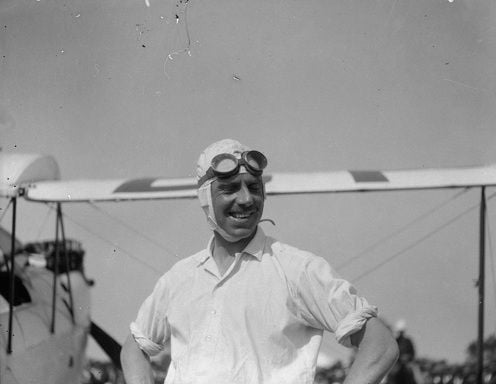
Geoffrey de Havilland, pictured in Perth in 1929
Using an aero engine he also designed himself, the aircraft crashed on its first flight. Undaunted, he went on to build a second aeroplane with which he taught himself to fly and subsequently sold it to his new employer, the Royal Aircraft Factory. He was poached in early 1914 to become Chief Designer at Airco, a private aircraft manufacturer based in Hendon, north London. Throughout the First World War Geoffrey designed successful aeroplanes for the Royal Flying Corps, from the DH.1 to the DH.9, which in its 9A variant went on to serve with the RAF for another two decades.
By 1918 Airco was the world’s largest aircraft manufacturer – but the end of the war and the consequent drop in sales proved fatal to the company. Despite moving into passenger aeroplanes the company remained unprofitable. It was finally taken over by BSA, of small arms and motor vehicle fame, in 1920, but Airco's new parent company only wanted factory capacity for their growing car business. This proved the opportunity Geoffrey was waiting for: he bought out the aircraft assets and set up shop under his own name in Edgware, near to Hendon, and later moved to premises in Hatfield, just up the road from the present-day museum.
The inter-war years
Initially de Havilland concentrated on the light aircraft market, producing a series of aircraft based on the Moth, an existing Airco design but using Geoffrey's own-designed Gipsy engines. Notable models included the first Moth, the DH.60 and the most famous of all Moths, the Tiger Moth, used widely to train military pilots well into the Second World War.
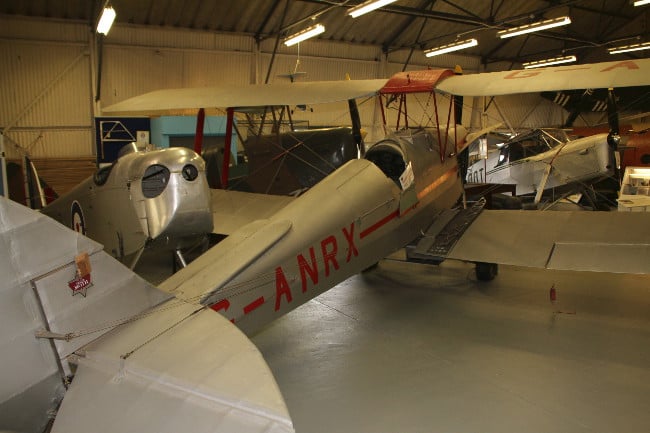
A de Havilland Tiger Moth, pictured at the de Havilland Museum
The basic plywood Moth design spawned many versions for specific purposes. A touring version, the DH.83 Fox Moth, had wings that folded back so you could tow it home easily. The larger DH.84 Dragon, a twin-engined development of the Fox Moth, was used for scheduled passenger and mail services, evolving into the iconic 1934 DH.89 Dragon Rapide. The most unusual was the Queen Bee: a Tiger Moth fitted with remote control equipment to serve as a anti-aircraft gunnery target. The museum has one – suggesting someone was not a terrific shot.
An important development of this period (but which I can't help feeling was done just for marketing) was the DH.88 Comet. This was in response to the MacRobertson International Race from London to Melbourne announced in 1933. With no British aeroplane of the time being suitable, Geoffrey de Havilland announced he would build one. His final design (which won the race in a time of 71 hours) was a wooden box construction covered in plywood and fabric with tuned Gipsy engines. Lightweight and extremely streamlined for better performance, it would serve, along with the four-engined DH.91 Albatross airliner as the forebear of the Mosquito to come.
The Second World War and the Mosquito
Having concentrated on building small, light aircraft, de Havilland was in danger of becoming simply a sub-contractor as the clouds of war began gathering over Europe in the mid-1930s. One market that did interest the company, though, was that for a twin-engined bomber, called for by the Air Ministry in specification P.13/36. de Havilland started by reworking the Albatross using Rolls-Royce Merlin engines but it fell short of requirements, prompting a radical rethink.
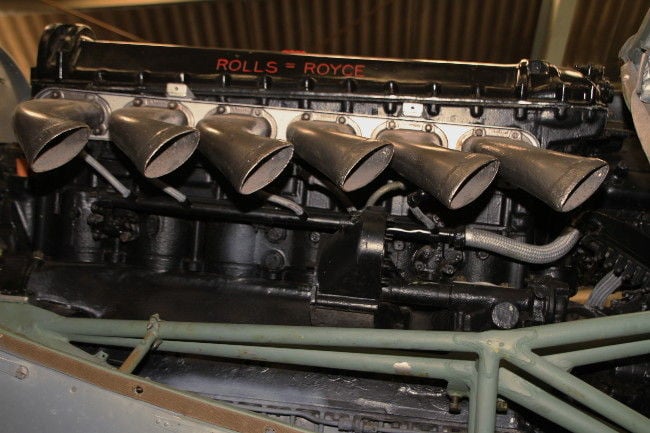
A Rolls Royce Merlin aero-engine, as installed on one of the museum's Mosquitoes
While the need was set down for an armed bomber capable of defending itself, de Havilland preferred the idea of an unarmed bomber using just its speed to avoid the enemy. It would be fast, streamlined and – in what would later prove a useful step – would be made of wood.
The idea was taken to the Air Ministry who showed no interest. What to do? Like a true entrepreneur with a vision, Geoffrey de Havilland started work anyway, in October 1939. The design team, initially comprising eight people, were moved away from the main manufacturing plant in Hatfield to the secrecy of Salisbury Hall a short distance away - which is, of course, the site of the current museum.
de Havilland's designers worked in the main hall of the moated manor house while the prototype airframe was assembled in a small hangar alongside, disguised as a farm building. The design was radical. Built almost entirely of wood, it was structured as a single wing, to which the engines and fuselage were simply attached with just four bolts. The structure followed that of the Albatross, with a wooden structure glued and screwed together (using 30,000 screws per aircraft), covered in plywood and then fabric.
No rivets meant a very smooth skin and with no gun turrets – a standard feature of bombers back then – a streamlined shape. Two Merlin engines supplied the power and the whole prototype was designed and put together in just eleven months. When ready to fly the pieces of plane (now given the company designation DH.98) were put on lorries, shipped to Hatfield, assembled again and the maiden flight was made.
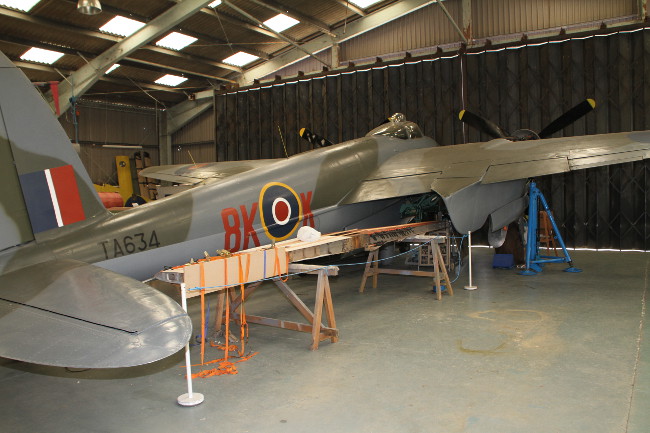
de Havilland Mosquito B Mk.35 TA634 at the de Havilland Museum
While having been started under its own steam the project now had some official backing, initially from Air Marshal (later Air Chief Marshal) Sir Wilfred Freeman, Air Member for Development and Production at the Air Ministry. Being made of wood it fulfilled a new requirement, B.1/40, for a fast long-range bomber-reconnaissance aeroplane made from “non-essential” materials: i.e. it wasn't metal, which was in short supply.
The new aircraft, named the Mosquito, easily surpassed expectations. During acceptance trials it reached 392mph and even outpaced a Spitfire in a head-to-head contest, leading to an initial order for fifty examples.
The sheer flexibility of the Mosquito airframe was its greatest strength. Built in two basic forms of fighter or bomber it performed a variety of tasks: night fighter; pathfinder; photo- reconnaissance; strategic bomber, sea patrol and fighter-bomber. Armament varied widely too: four .303” Browning machine guns and four 20mm Hispano cannon were the normal complement for a fighter variant, with hardpoints available for bombs, anti-ship torpedos and rockets in later years. Even a bomb bay-mounted 57mm anti-tank gun was installed on the FB.Mk XVIII.
The "Mossie" saw use throughout the war, with one of its most famous roles being in the Pathfinder squadrons. Here the Mosquito units led streams of four-engined heavy bombers to their targets by using the Oboe navigation system, which greatly increased the effectiveness of night bombing campaigns. Of higher profile was the strategic bombing of the Gestapo's Oslo headquarters and the Amiens prison raid; the approaches for these raids being made at just 60 feet above ground level for maximum surprise.
Arguably the finest aircraft of the war, the Mosquito's era ended as jet engines broke new performance records, but the company continued to forge ahead.
The post-war years and the de Havilland Museum: 1945 – 1960
de Havilland entered the jet era in typical fashion by putting its broad range of aero-engineering skills straight to use. Not only did it make its own jet engines (the Halford H.1 being the first, used initially in the rival Gloster Meteor) but it produced complete military and commercial aircraft of often radical design, such as the tailless, ill-fated DH.108 Swallow, all three examples of which were destroyed in fatal crashes. One such crash claimed the life of Geoffrey de Havilland Jr., son of the company's founding father, in 1946.
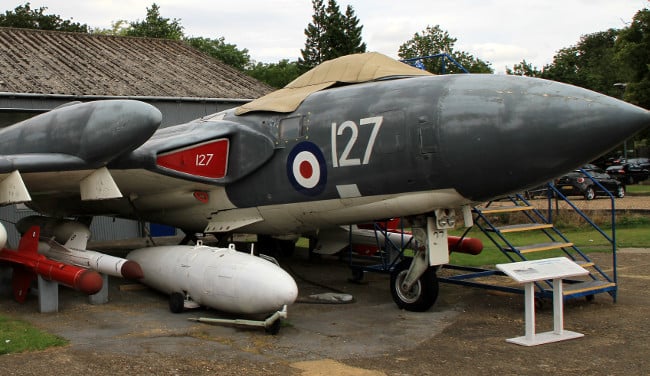
A well-weathered de Havilland Sea Vixen at the museum
Operational roles started with the twin-boom DH.100 Vampire jet fighter and continued with the similarly equipped DH.110 Sea Vixen for carrier deployment with the Royal Navy's Fleet Air Arm. In the commercial field de Havilland was equally ambitious and with the DH.106 Comet launched the world’s first commercial jet airliner in 1952. Early aircraft failures due to challenges previously never encountered by aircraft manufacturers led to extensive redesign work and slow sales, but despite rivals such as Boeing learning from de Havilland’s problems and leaping ahead, the Comet astonishingly continued in service until 2011, in the form of the RAF Nimrod airborne early warning aircraft.
Despite other advanced work on Blue Streak ballistic missiles and even satellite launch rockets de Havilland was unable to gain enough commercial contracts and in 1960 was taken over by Hawker Siddeley. The company's designs continued, with the DH.121 entering commercial service as the Hawker Siddeley Trident, but the iconic name eventually disappeared. Hawker Siddeley itself disappeared into British Aerospace in the 1977 nationalisation of the remains of the British aerospace industry. An era of British private aircraft companies, led by its most pioneering engineers, passed into the history books.
The museum
The museum itself is a delight and a wonderful example of what can be achieved by volunteer enthusiasts rather than government largesse.
Yes, it can appear ramshackle but that’s part of the charm. It remains completely run by volunteers and without any government support the musuem has added hangars and exhibition space as funds allow, and continues to restore and maintain the planes held there in full view of visitors. The volunteer ethos running through the museum also means more interaction than you would expect.
The team like messing about with aeroplanes and so want you, the visitor, to get as hands-on as possible too. If an airliner's door is open, poke your head in and have a look about. If a cockpit is open, jump in and feel for yourself what flying that aircraft must have been like.
The initial push to preserve and display de Havilland aircraft came from a Walter Goldsmith who bought Salisbury Hall after the war and realised the Mosquito had been designed there. Contacting the company's PR department, he found out the original prototype, serial number W4050, was still in Hatfield and needed a home, which he graciously offered. The Mossie arrived in 1959, making the de Havilland Museum the oldest aircraft museum in the country and unique in displaying a prototype on the original site where it was designed and built.
Over the years more aircraft arrived, always with an association with de Havilland or the site itself. Early pre-war exhibits include the Tiger Moth and the aforementioned Queen Bee, plus oddities such as a Cierva C.24 helicopter, for which de Havilland produced the airframe. The Second World War part of the museum is all about the Mosquito and they have three examples, the world’s largest group of the aircraft. Alongside the prototype are both fighter and bomber variants plus an extensive display of weaponry options, including the impressive 4,000lb blast bombs, cannon and machine guns.
They also have examples of the drop fuel tanks used to extend aircraft range and even bulletproof windscreens! Another item of note from this period is a section of Handley Page Horsa fuselage, from a glider used to drop paratroopers behind enemy lines.
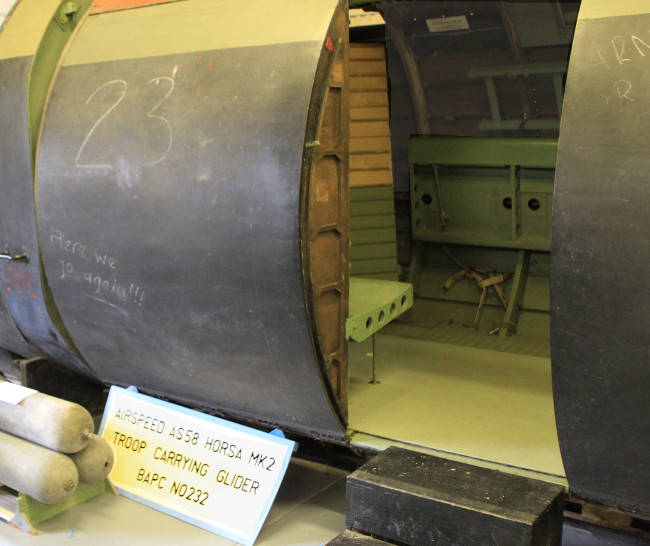
Jump in: Visitors can enter the Handley Page Horsa troop-carrying glider
Aeroplanes from the post-war period are well represented and, being larger, can be mainly found outside. They include the Vampire and Sea Vixen military jets and examples of both the Comet and Trident airliners, plus light training aircraft such as the Chipmunk.
Alongside the planes are also displays on the company history and development of the jet engines from the later years. The museum is completed by of course the museum shop, for you to stock up on aircraft models, books and the necessary refreshments. You can still see the original hangar entrance set in concrete next to the hall.
Behind it are newer hangars housing the older airframes but the future will hopefully be built behind these; a new hangar to move almost all the aeroplanes under cover and help preserve them for future visitors. Planning permission has been requested, now it’s up to you. Go visit and help them raise the funds they need to build it. ®
GPS
51.710943,-0.270534
Postcode
AL2 1BU
How to get there
The museum is located next to Salisbury Hall at junction 22 of the M25. NB: If you are travelling clockwise on the M25 (ie: from Heathrow, M1) you will need to cross back over the bridge on the M25.
The museum is sign posted ‘Mosquito Museum’ from the London Colney roundabout and is on the B556 to South Mimms.
Entry
The museum is open from the first Sunday of March to the last Sunday of October. Opening times are eccentrically Tuesdays, Thursdays and Saturdays from 12:00 - 17:00, then Sundays and Bank Holidays 10:30 - 17:00 with last entry at 16:00.
The cost of entry is £6.00 for adults, £5 for senior citizens / students and £4 for children of 4+. Family tickets are at £16.00. Private tours and group booking by arrangement, phone for details. See the official website for more details.
Website
http://www.dehavillandmuseum.co.uk
Nearby
- St Albans
- Willows Farm - good for smaller children who may not want to look round the museum.
- Colney Fields Retail Park – Museum volunteers suggest it’s a good place to drop off reluctant members of your family!